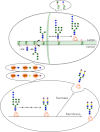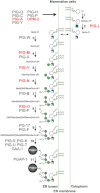Understanding human glycosylation disorders: biochemistry leads the charge
- PMID: 23329837
- PMCID: PMC3591604
- DOI: 10.1074/jbc.R112.429274
Understanding human glycosylation disorders: biochemistry leads the charge
Abstract
Nearly 70 inherited human glycosylation disorders span a breathtaking clinical spectrum, impacting nearly every organ system and launching a family-driven diagnostic odyssey. Advances in genetics, especially next generation sequencing, propelled discovery of many glycosylation disorders in single and multiple pathways. Interpretation of whole exome sequencing results, insights into pathological mechanisms, and possible therapies will hinge on biochemical analysis of patient-derived materials and animal models. Biochemical diagnostic markers and readouts offer a physiological context to confirm candidate genes. Recent discoveries suggest novel perspectives for textbook biochemistry and novel research opportunities. Basic science and patients are the immediate beneficiaries of this bidirectional collaboration.
Figures



References
-
- Matthijs G., Rymen D., Millón M. B., Souche E., Race V. (2013) Approaches to homozygosity mapping and exome sequencing for the identification of novel types of CDG. Glycoconj. J. 30, 67–76 - PubMed
-
- Saunders C. J., Miller N. A., Soden S. E., Dinwiddie D. L., Noll A., Alnadi N. A., Andraws N., Patterson M. L., Krivohlavek L. A., Fellis J., Humphray S., Saffrey P., Kingsbury Z., Weir J. C., Betley J., Grocock R. J., Margulies E. H., Farrow E. G., Artman M., Safina N. P., Petrikin J. E., Hall K. P., Kingsmore S. F. (2012) Rapid whole-genome sequencing for genetic disease diagnosis in neonatal intensive care units. Sci. Transl. Med. 4, 154ra135 - PMC - PubMed
-
- de Ligt J., Willemsen M. H., van Bon B. W., Kleefstra T., Yntema H. G., Kroes T., Vulto-van Silfhout A. T., Koolen D. A., de Vries P., Gilissen C., del Rosario M., Hoischen A., Scheffer H., de Vries B. B., Brunner H. G., Veltman J. A., Vissers L. E. (2012) Diagnostic exome sequencing in persons with severe intellectual disability. N. Engl. J. Med. 367, 1921–1929 - PubMed
-
- Mefford H. C. (2012) Diagnostic exome sequencing–are we there yet? N. Engl. J. Med. 367, 1951–1953 - PubMed
-
- Committee on Assessing the Importance and Impact of Glycomics and Glycosciences, Board on Chemical Sciences and Technology, Board on Life Sciences, Division on Earth and Life Studies, and National Research Council (2012) Transforming Glycoscience: A Roadmap for the Future, The National Academies Press, Washington, D.C. - PubMed
Publication types
MeSH terms
Substances
Grants and funding
LinkOut - more resources
Full Text Sources
Other Literature Sources
Molecular Biology Databases

